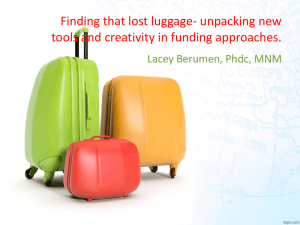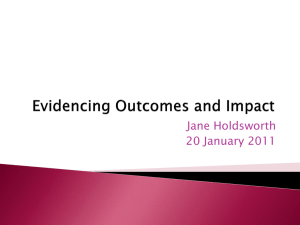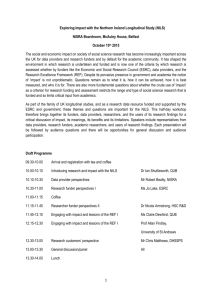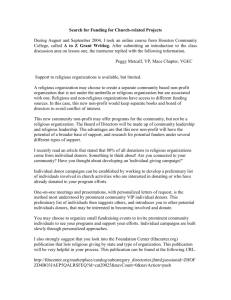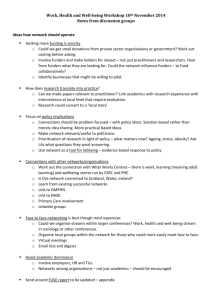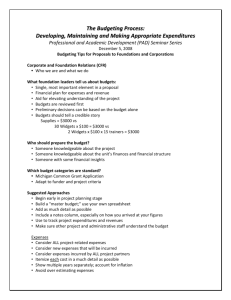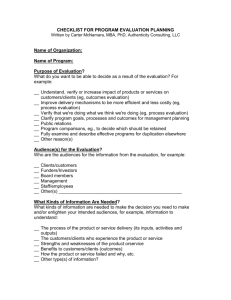A proposal for Cash on Delivery Aid P a
advertisement
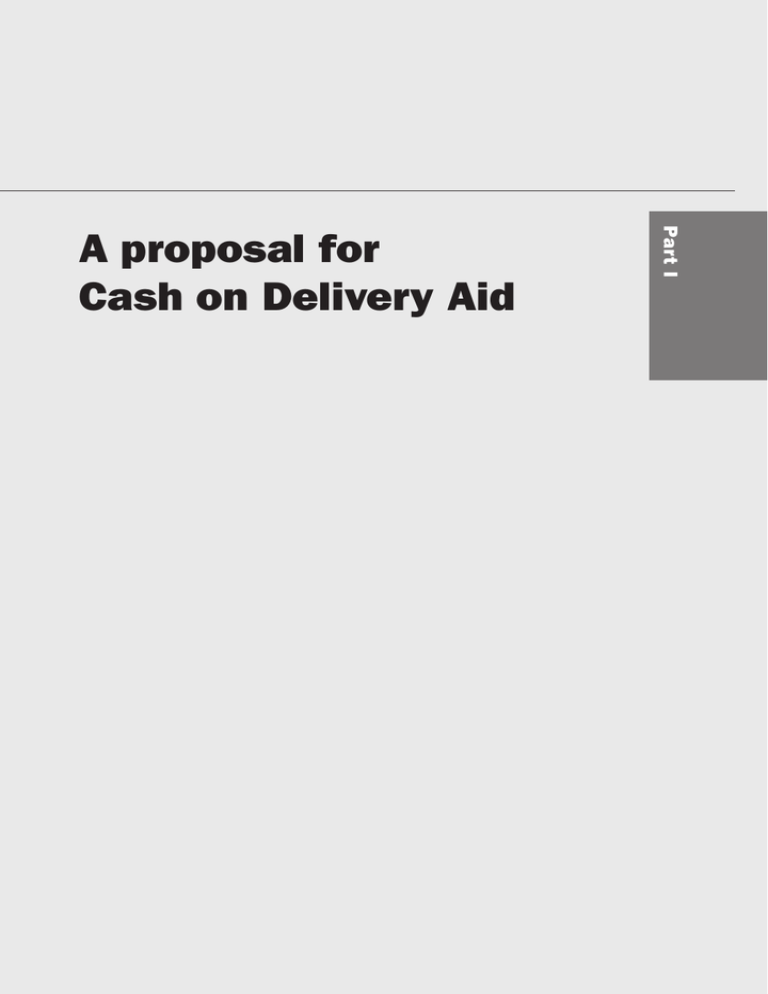
Part I A proposal for Cash on Delivery Aid 3 Foreign aid has become a big and difficult business. In the last decade, official aid has grown faster than ever.1 In 2000, the international community committed itself to help developing countries achieve the Millennium Development Goals. As part of this commitment, developed countries promised to increase foreign aid substantially—doubling or, for Africa, tripling their annual aid flows.2 Foreign aid has grown significantly since 2000, especially if debt relief for the poorest countries is included. By 2007, it amounted to more than $120 billion a year (figure 1.1). In the same period, private giving in support of nonprofit and philanthropic international programs also rose substantially. Despite this impressive infusion of resources, the flow of aid now faces two big challenges. One is whether economic recession in funder countries will undercut official commitments to provide more aid. The second is whether the sheer number of public and private funders with multiple objectives, procedures, and cultures will fragment and further weaken what has always been fragile public support for aid. Aid going directly to governments in low-income countries seems at greatest risk of losing public confidence. We believe that aid, both public and private, can make a difference in improving lives in poor countries. We also believe that the willingness of taxpayers and private funders to finance aid programs depends more than ever on evidence that aid programs deliver. To keep public support, aid programs must help generate measurable progress on some dimensions in aidrecipient countries. In response to the growing pressure to show that aid can deliver, official and private funders have already begun to implement various approaches to aid that pays for results. This book, building on concepts first proposed in Barder and Birdsall (2006) and benefiting from the experience Chapter 1 Buying things versus buying development 4 Chapter 1 Figure 1.1 Foreign aid has increased significantly since 1960 Total official development assistance ($ billions) 150 125 100 75 50 25 0 1960 1965 1970 1975 1980 1985 1990 1995 2000 2007 Note: The figure depicts the growth of foreign aid for all donors using data on total net official development assistance flows. Source: OECD Stat Extracts, Table 2a. of current efforts, explores a results-based approach and takes it an ambitious step further. In this chapter we assess the fundamental shortcomings of the current aid system and the fairly limited success of reform programs to address them. In the next, we outline our proposal for what we call Cash on Delivery Aid (COD Aid). Aid and its critics For all the good that foreign aid can do in vaccinating children or building schools and roads, aid has never been without its critics, who fall into two camps. Some argue that aid actually undermines development. Others—with whom we agree—believe that the foreign aid system can work, but only if seriously reformed.3 Critics in the first camp assert that foreign aid can undermine development in several ways. Aid inflows that are large relative to the local economy can inflate exchange rates and penalize a country’s exports. Aid programs also increase demand for local people skilled in management and administration, thus competing with both the private sector and the government. This can result in a lack of management skills for administering not only aid programs but also all Critics in the public functions (box 1.1). Aid can also reduce incentives to improve first camp assert revenue collection, allow governments to delay difficult reforms, and that foreign aid encourage rent-seeking by powerful political and economic elites. And can undermine it can weaken or distort local political and other institutions by making development in a government accountable primarily to its foreign funders rather than several ways to its citizens. Finally, some argue that aid can undermine a country’s Buying things versus buying development Box 1.1 Administrative costs can burden recipients: Vietnam Although foreign aid provides governments with additional funding to implement beneficial projects, the administrative costs of traditional aid can be substantial and burdensome for the public sector in recipient countries. In 2002, Vietnam received about $1.3 billion from about 44 official donors. An additional 350 international nongovernmental organizations (NGOs) contributed funds and operated in Vietnam that year. 5 Overall, foreign funding supported more than 8,000 development projects. Although these projects addressed critical needs of the Vietnamese people, they also imposed a large burden on Vietnamese officials, who were required to submit thousands of quarterly reports and host hundreds of donor visits that year. The demands on these officials to report to donors may have diverted their talent from other important functions. Source: DAC2a ODA Disbursements Table, OECD Stat Extracts; Acharya, de Lima, and Moore 2003; Knack and Rahman 2004. development by interrupting self-discovery, the process for countries to develop their own institutions and capacities for effective governance, strong economies and robust political systems through experiment and learning by doing. Critics in the second camp recognize many of the same shortcomings. Rather than seeing these shortcomings as inherent to foreign aid, they see them as failings of the official global aid system—which, if seriously reformed, could work much better. For this second group of critics, foreign aid is too often designed to primarily serve domestic constituencies in funder countries. This leads to such detrimental practices as tied aid, requiring that aid be spent on the funder country’s own products and services. They also note that the foreign aid system has high transaction costs. These result from the fragmentation of programs, a multitude of funders operating in any given country, a bias toward funder involvement in project design and implementation as the solution to weak local execution, and—as emphasized below—a focus on program inputs rather than on desired outcomes (less easily monitored and managed). Critics in the reformist camp also draw attention to domestic political and economic cycles in funder countries, amplifying volatility in foreign aid and hindering proper planning and implementation in recipient countries. Finally, these critics are conCritics in the cerned that funders have difficulty learning from their experiences— second camp not only because evaluation is complicated and costly but also because see that the aid proponents hesitate, with some justification, to advertise the limits official global of their craft.4 aid system, We believe that the concerns of both sets of critics overlap in many if seriously ways. For example, the accountability problem emphasized by those who reformed, could think foreign aid is inherently flawed is closely associated with the focus work much better on inputs, high transaction costs, and lack of local learning emphasized 6 Chapter 1 by those who think aid can be reformed. We argue in the next chapter that most of these problems could be avoided if funders linked some of their aid to agreed-upon and measurable outcomes rather than inputs. Past and current efforts to reform aid Criticism of foreign aid has a long history. Funders have generated a variety of strategies in response, with mixed success. For many years, critics had argued that traditional investment loans were failing to help low- and middle-income countries develop because poor public policies constrained growth. In the 1980s, the World Bank and other official creditors responded to these concerns by introducing conditionality. Loans and grants were made on condition that a country adopt such public policies as fiscal discipline, monetary restraint, and more liberal trade and financial policies. Evidence mounted, however, that such conditions rarely succeeded. First, reforms were implemented only when governments were already committed to the policy reforms. Second, funders were often unwilling to enforce conditions, approving waivers or softening requirements rather than walking away from programs and governments they were anxious to continue supporting.5 Doubts also grew about the value of the reforms themselves.6 Although conditionality remains a part of the aid system, it has fallen out of favor as a response to the aid system’s core problems. In the mid-1990s, the World Bank and several bilateral aid agencies adopted process conditions as a next promising approach. On the premise that successful development demands domestic ownership and involvement in the design and implementation of programs, funders required recipient governments to engage in consultations, planning exercises, and assessments with the participation of nongovernmental organizations, local communities, and domestic interest groups. The most prominent example of these process conditions is the Poverty Reduction Strategy Paper, requiring that low-income countries seeking aid reach a broad consensus on public policies in many sectors with the involvement of local groups. This approach has not increased country ownership or aid effectiveness, even according to the A recent World Bank’s own evaluations.7 response to the A more recent response to the criticism has been to steer foreign aid criticism has away from specific projects and toward broader sectoral or national budbeen to steer get financing. This approach rewards responsible management with direct foreign aid away budget support. For example, the World Bank allocates its most concesfrom specific sional funding in part on indicators of good governance in low-income projects and countries. Its policy-based loans support budget expenditures of recipient toward broader governments. The European Union and the U.K. government also prosectoral or vide budget support, paying unrestricted funds to the national treasuries national budget of governments judged to have reasonably good expenditure management financing and adequate financial controls. Buying things versus buying development 7 Figure 1.2 Traditional aid continues to dominate World Bank loans for primary education . . . Development policy loans $20 million Adaptable program loans $18 million Emergency recovery loans $20 million Specific investment loans $644 million Note: Data are for fiscal 2008. Source: World Bank, Human Development Network. Figure 1.3 . . . and in countries that receive budget support, such as Malawi Pooled funds $82 million Budget support $95 million Project support $361 million Note: Data are for fiscal 2008. Source: Malawi Ministry of Finance. These reform strategies, especially budget support, have reduced the administrative burden on recipient governments and are more likely to encourage their ownership of programs. In that sense, they are a step in the right direction. But the strategies still cover a relatively small portion of total transfers, even for the World Bank (figures 1.2 and 1.3). Budget support and policy-based loans also continue to require substantial ongoing funder scrutiny of country spending and other management systems to minimize the risk of waste and corruption. In addition, they tend to be based on funders’ judgments that the plans are adequate or policies acceptable, and thus do not fully empower recipients, and they make it hard for funders to reduce or withdraw support. Since clear measures of government performance are difficult to define ex ante, failure to meet them is difficult to establish ex post. Such failures cannot then be invoked as a reason to halt disbursements.8 Moreover, budget support and policy-based loans are available only to a small group of eligible countries with demonstrated track records of 8 Chapter 1 good management. So, the approaches cannot be forward looking—or provide aid in countries where, despite honest and responsible leadership, the current limitations of administrative and financial management make them ineligible.9 As outside criticism of aid has continued and concerns have grown in official aid quarters, the major funders have articulated and begun to reform the overall aid system. The Paris Declaration, signed in 2005 by more than 90 countries and multilateral organizations, committed the major funders of foreign aid to an ambitious set of reforms, including: • Increasing a recipient country’s ownership of initiatives financed with foreign aid. • Harmonizing the design, implementation, and reporting of foreign assistance by different organizations. • Aligning foreign aid with the recipient country’s priorities, systems, and procedures. • Focusing on results and outcomes as measures of performance. • Improving accountability of both funders and recipient countries for the effective use of foreign aid. • Increasing the predictability of foreign aid to help recipient governments better plan and manage their own budgets. So far, however, progress has been limited, as documented by official monitoring reports.10 Why has reform been so difficult, despite substantial resolve and attention on the part of aid officials in virtually all the major funder countries and in the World Bank and other multilateral organizations? What fundamental problems have the efforts so far failed to tackle effectively? Why is foreign aid difficult to do well? An enduring challenge of foreign aid is accountability. In countries that rely fully on tax revenue to finance government programs, taxpayers play a critical role in monitoring government behavior. They can observe the results or outcomes in, for example, road maintenance and school quality, and hold governments accountable for those results. But in countries that rely in part on aid, citizens lack similar incentives and mechanisms for monitoring and enforcing good government performance, particularly where democratic norms are not well established. Faced with this weak local accountability, funders tend to finance and monitor inputs, aid programs which are easier to track and come sooner in any program but are a poor and policies proxy for the results or outcomes funders actually want to support. The are only weakly fundamental problem of accountability in aid transfers is manifested in accountable three forms.11 to citizens of First, aid programs and policies are only weakly accountable to citizens funder countries of funder countries. These programs have multiple, often contradictory Buying things versus buying development 9 goals and report little on their achievements, if at all. Although parliaaid programs ments may investigate and criticize programs, voters rarely base their elecand policies are toral decisions on aid effectiveness, which is only one small part of the even more weakly broader political debates in any country. This weak accountability opens accountable space for funding agencies and interest groups to modify foreign aid for to citizens any number of legitimate or illegitimate goals—from geopolitical supof recipient port and national security cooperation to policies favored on ideological countries grounds and benefits for domestic corporations. Second, aid programs and policies are even more weakly accountable to citizens of recipient countries. Rightly or wrongly, funders see themselves as responsible for ensuring that foreign aid is used appropriately. They therefore insist on determining the standards for setting priorities and for designing and monitoring programs. These standards reflect their own perspectives and requirements, even where the recipient country’s citizens can hold their governments accountable at the polls. Since the citizens do not provide the funds for development programs, their interest and ability to hold domestic politicians accountable for those funds is greatly limited. Third, and ironically, funders and recipient governments, though generally considered partners in the official aid world, are only weakly accountable to one another. Recipients regularly criticize funders for being inflexible, unresponsive, and unpredictable. Funders, for their part, criticize recipients for a lack of transparency and a failure to fulfill obligations. These problems are only exacerbated by an increase in the number of funders and by their different budget cycles and reporting requirements. Because the recipient’s accountability to any single funder is diluted, transaction costs rise, as does the administrative burden on recipient governments. Accountability is only one of the enduring challenges of foreign aid. Another is the divergence between objectives of funders and recipients. For any particular grant or aid transfer, the funder and the recipient may not agree fully on the objective. They may both want to see more children learn more in school, for example—but the funder may also want to procure a textbook contract for the home country (an input), provide consultancies (another input), or simply buy the allegiance of a recipient government to its broader foreign policy goals. The recipient government, in turn, may place a high priority on creating jobs (through school construction) or mollifying the teachers’ union (by allowing paid double shifts), independent of any tradeoff with maximizing what children learn. Beyond challenges of accountability and divergent objectives, another stumbling block is asymmetric information. Even when there is reasonably good alignment of funder and recipient objectives, the funder and recipient may not have the same information or the same perspective on what might be called the local production function—the mix of inputs in a particular setting that buys the best and greatest outcome at the lowest cost. Continuing the education example, the funder may believe 10 Chapter 1 the right inputs are those for improving the quality rather than expanding the quantity of current education, or the funder may be committed to funders and decentralization as a key strategy. Such commitments may follow either recipient from the funder’s direct experience elsewhere or from the funder’s reading governments of the current views of international experts. The recipient government, are only weakly by contrast, may be convinced that the long-run low-cost path to increasaccountable to ing learning in its country is to maximize enrollment, even at some cost one another to quality in the short run. Compounding the lack of shared information about what is likely to work at the start of a new program is the asymmetry that tends to accumulate once a program is implemented. No matter how much attention the funder pays to monitoring the cost and allocation of the inputs it is financing, the funder is likely to have less information about exactly how those inputs are being combined with other inputs provided by the country and translated (or not) into the desired outcomes. The combination of overlapping but divergent objectives with unshared and asymmetric information, particularly in a context of insufficient accountability, has produced the problematic relationship between funders and recipients at the heart of the many apparent failures of aid programs. and ironically, The principal-agent problem in foreign aid Despite some shared overarching goals, funders and recipients may work at cross purposes when their interests do not align and they have different access to information. In such circumstances, generating mutually beneficial outcomes is difficult. Economists have developed principal-agent models to study such dilemmas and explore conditions that would yield mutually beneficial outcomes. Among the standard solutions to the principal-agent problem are cost-reimbursement and fixed-price contracts.12 Either will motivate an agent to achieve a principal’s goals. Consider when a government, the principal, hires a company, the agent, to build a road. In a cost-reimbursement approach, the government reimburses the company for the cost of building the road, perhaps with an added margin for normal profits. With a fixed-price contract, by contrast, the government pays the company an agreed amount for delivering a completed road, regardless of its cost. Under the cost-reimbursement contract, the government assumes all the risks of potential cost overruns, and the company has little incentive to save money. Under the fixed-price contract, the company assumes all risks for cost overruns and is paid only if it completes the work. Foreign aid has traditionally used the cost-reimbursement approach, particularly when specific investment projects are involved. Funders have assumed the risk; recipients have had little incentive to contain costs. In recent decades, aid agencies Buying things versus buying development 11 have tried to shift toward fixed-price contracts in the form of policyfunders and based loans with conditionality from the World Bank and the Internarecipients both tional Monetary Fund or as budget support from bilateral agencies. In have strong theory, recipients must achieve certain goals for funders to disburse the political pressures money. to disburse aid The traditional cost-reimbursement mindset, in particular, has led payments funders and recipients into two patterns that consistently keep them from efficiently achieving their aims. In one pattern, funders who risk cost overruns (whether the project turns out to be more expensive than originally estimated or reaches fewer beneficiaries than anticipated) seek more and more detailed information to assure themselves that the recipient government is exerting sufficient effort, implementing the right strategy, and buying inputs at the lowest cost. This not only increases costs of monitoring and administration but also implicitly demonstrates a lack of trust between the funder and recipient. Small wonder that recipients react to calls for additional reports as an unnecessary burden and even an affront. In the second pattern, recipients who bear less risk under cost-reimbursement contracts have little incentive to use funds efficiently. Indeed, higher costs or failures to realize benefits can favor a new round of funding. Blame for failure under these contracts is hard to assign, reducing the likelihood of any consequences. Recipients can argue, often legitimately, that the funder’s plan or technical support was inadequate. Funders can point to a recipient’s failure to allocate enough effort to implement what was otherwise a perfect plan. A shift toward paying fixed prices for deliverables, in the form of budget support and policy conditionality loans, has improved the situation somewhat. In these programs, funders and recipients negotiate targets, and funders agree to make payments if targets are met. However, such contracts have been undermined by a lack of clarity over targets and too great an openness to renegotiation. Since the goals of these sector and good governance programs are often broad, precise and independent measures of progress are difficult to specify. Furthermore, funders and recipients both have strong political pressures to disburse aid payments and have tended to soften conditions or offer waivers to ensure that funds are disbursed.13 Given the problems with fixed-price agreements, why haven’t aid agencies done more to specify targets and outcomes? The most common objection is that buying development is not as easy as buying a road. Making a fixed-price contract requires specifying the service with enough precision to know when it has been delivered. Improving health, educating children, or reducing poverty seem difficult to describe as deliverable. Yet this only begs the question. If measurable products in these areas could be specified, wouldn’t a fixed-price contract be worth trying? 12 Box 1.2 Selected meetings and events with discussions of COD Aid Center for Global Development. Expert Panel Discussion. Including Australia Aid Agency by video conference. May 25, 2007. Washington, D.C., and Canberra. Center for Global Development. Policy-Maker Workshop on Progress-Based Aid. October 2007. Washington, D.C. Fast Track Initiative Meeting. December 9–11, 2007, Dakar. Center for Global Development. Workshop on Progress-Based Aid. February 19–20, 2008. Washington, D.C. Mexican Ministry of Education and Mexi����� canos Primeros. Apoyo Basado en Resultados—Cash on Delivery Aid workshop. March 11–12, 2008. Mexico City. Education for All—Fast Track Initiative Technical Meeting. Mobilizing Additional Resources for Education. April 24, 2008. Tokyo. Center for Global Development. Peer Review of the Preliminary Cash on Delivery Aid Manuscript. September 17, 2008. Washington, D.C. Bill and Melinda Gates Foundation. Video Conference on Cash on Delivery Aid and Its Chapter 1 Application to Health. September 18, 2008. Washington, D.C., and Seattle. Hemispheric Think Tank Working Group. September 22, 2008. Ottawa. Tanzanian president and delegation. September 27, 2008. Washington, D.C. Global Partnership on Output Based Aid. September 29, 2008. Washington, D.C. Swedish state secretary and delegation. October 9, 2008. Washington, D.C. World Bank Operations Policy and Country Services. October 22, 2008. Washington, D.C. United Nations Follow-up International Conference on Financing for Development to Review the Monterrey Consensus. Cash on Delivery Aid Roundtable Discussion. December 2, 2008. Doha. Hemispheric Think Tank Working Group. January 13, 2009. Washington, D.C. Canadian International Development Agency. January 22, 2009. Ottawa. Aid Watch. What Would the Poor Say? Debates in Aid Evaluation. February 6, 2009. New York City. Johns Hopkins School of Advanced International Studies. Development Roundtable. February 13, 2009. Washington, D.C. World Bank Europe and Central Asia Division. What Does It Take to Innovate for Achieving A second objection is that such contracts impose the risk on recipient governments, which are, it is argued, less capable of bearing financial risk. While this may be true, the international discourse is rejecting the paternalistic notion that developing countries are better off when they implement programs designed and supported by funders. Ownership by developing countries will be fully realized, according to this perspective, only when they assume the full risks (and benefits) of their actions. It is fundamentally inconsistent to promote the idea that developing countries should have more control over their own programs and policies while purporting to protect them from bearing the risks and consequences of their decisions. And current aid modalities impose high risks on recipient governments anyway, since the funds are notoriously volatile and unpredictable.14 While additional objections could be discussed, suffice it to say that the fixedprice approach to solving the principal-agent problem in foreign aid merits further Buying things versus buying development 13 Box 1.2 (continued) Selected meetings and events with discussions of COD Aid Results in Europe and Central Asia? February 18, 2009. Washington, D.C. World Bank Latin America and Caribbean Division. March 19, 2009. Washington, D.C. World Bank Sustainable Development Network. Results Days. March 25, 2009. Washington, D.C. U.S. State Department and U.S. Agency for International Development. April 16, 2009. Washington, D.C. Global Philanthropy Forum. Eighth Annual Conference. April 22, 2009. Washington, D.C. Tanzanian Development Partners. Video Conference on Cash on Delivery Aid. May 6, 2009. Dar es Salaam, Washington, D.C., and Addis Ababa. United Nations Economic Commission for Africa. Trade, Finance and Development Division Seminar on Cash on Delivery Aid. May 2009. Addis Ababa. Sixth Plenary Meeting of the Leading Group on Innovative Financing for Development. May 29, 2009. Paris. The Office of Congressman Sam Farr. Policy Discussion on Conditional Cash Transfers. June 19, 2009. Washington, D.C. European Commission. Meeting of EU Member States Education Experts. June 25, 2009. Brussels. Liberian Education Minister. November 18, 2009. Washington, D.C. Civil Society Forum of the World Bank and International Monetary Fund Fall Meetings. The Aid System: Does Mutual Accountability Encourage Outcomes. October 4, 2009. Istanbul. Malawian Ministries of Finance and Education. October 6, 2009. Lilongwe. Malawian Development Partners. October 9, 2009. Lilongwe. Swedish Ministry of Foreign Affairs and Swedish International Development Cooperation Agency. October 22, 2009. Stockholm. Liberian Planning and Economic Affairs Minister and Deputy Minister. November 18, 2009. Washington, D.C. exploration. The approach diminishes the need to monitor inputs and focuses more on measuring outcomes. It assigns greater responsibility to recipients while increasing the accountability of both funders and recipients to their citizens. Efforts to reform aid are clearly moving in this direction, but they remain largely limited to marginal changes in the traditional approaches.15 Such partial reform recognizes the need to give recipient countries more responsibility for their programs, encourage innovation and learning, simplify the engagement between funders and recipients, and increase accountability by focusing on outcomes, but it continues to pay more attention to getting the right plan and implementation strategy than to getting the right measures of progress, the right incentives, and the right distributions of responsibilities. More thorough reform is needed; this book presents one possible approach. Our proposal, COD Aid, has been developed, critiqued, and improved in a comprehensive process of research and consultation. We undertook new research, commissioned background papers from experts, interviewed dozens of practitioners, and engaged 14 Chapter 1 in extensive consultations with officials, technical experts, and civil society representatives to further assess and refine the idea. We also convened meetings to discuss COD Aid and made presentations and responded to comments at events sponsored by others. (A list of meetings and events is included in box 1.2). This book presents the results of that work. The next chapter describes the key features of COD Aid and discusses how it helps funders and recipients tackle the fundamental challenges to making aid work: accountability problems; divergent objectives; and poor and unshared information about what works. Notes 1. Official aid includes aid from governments (bilateral aid) and aid financed or provided by UN agencies, the European Union, and multilateral development banks. 2. Rough estimates of the cost of meeting the Millennium Development Goals beyond what aid-recipient countries could finance were on the order of $50 billion a year in 2000 (Levine, Birdsall, and Ibrahim 2003). The Commission on Africa, chaired by U.K. Prime Minister Tony Blair, recommended in 2005 that donors double their annual aid to Africa by 2010 (Commission for Africa 2005). 3. For criticism of foreign aid, see Birdsall (2008); Easterly (2006); Hausmann and Rodrik (2002); Moss, Pettersson, and van de Walle (2006); and Rajan and Subramanian (2005). 4. On why impact evaluation has been uncommon, see Savedoff, Levine, and Birdsall (2006). Birdsall (2008) cites limited evaluation as one of funders’ seven deadly sins. See also Pritchett (2002) on incentives not to evaluate. 5. In most cases, countries continued to receive loans and grants whether they were fulfilling conditions or not (Birdsall, Claessens, and Diwan 2003). 6. Chang 2005. 7. World Bank (2004) evaluates progress in the implementation of Poverty Reduction Strategy Papers. Studies that question the effectiveness of Poverty Reduction Strategy Papers (PRSPs) and the quality of participation include Birdsall (2008), Christian Aid (2001, 2002), Easterly (2006), and Ranis (2008). Ranis (2008) reports that at a Kampala meeting “fifteen African countries denounced the PRSPs as structural adjustment loans in sheep’s clothing.” 8. Birdsall (2007) refers to this as the problem of exit. Selowsky (2003) also documents the tendency to waive conditions on adjustment loans, which are essentially predecessors of budget support. 9. This is often the case for fragile states. For a definition of fragile states, see OECD (2006). For information on the limitation of aid to these types of states, see Development Assistance Committee (2008a); Fritz and Menocal (2007); Grindle (2007); Cammack (2007); and Randall (2007). 10. Development Assistance Committee 2008b. Buying things versus buying development 15 11. These problems can exist in any type of transfer, including one from central to local governments. See chapter 6. 12. See, for example, Milgrom and Roberts (1992). 13. Killick 1998; Devarajan, Dollar, and Holmgren 2001; Easterly 2002. 14. Kharas 2008. 15. For example, in the Accra Agenda for Action (an agreement ratified by the delegates to the Third High Level Forum on Aid Effectiveness in Accra, Ghana, in September 2008) funders called for more transparency but created no new incentives for it.
